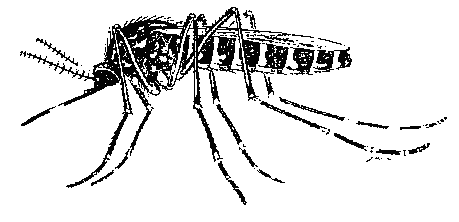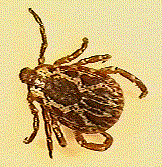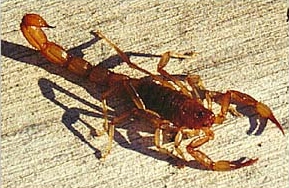|
| |
Mosquitos * Ticks * Deer Flies * Scorpions * Spiders
Mosquitos
 Mosquitos are found almost anywhere there is water. They tend to be most abundant in wooded areas during the summer months, particularly near marshes, bogs, and lakes that can provide breeding grounds for mosquito larvae. Although most people consider mosquitos to be pests, they are an important part of the ecology and provide food for birds and fish. Mosquitos are attracted to bright colors, particulary red, as well as dark colors resembling the fur of animals. They also like sweet or floral scents, as in deodorants and perfumes, and are repelled by body odors. The most effective insect repellents are those containing diethyltoluamide (DEET). Otherwise, wearing heavy, light-colored clothing, foregoing baths, and leaving perfumes and deodorants home are your best options. Other tricks include standing in a windy area as this prevents mosquitos from landing on you, standing in the middle of a large flat rock as mosquitos are more likely to hover over grassy areas, or burning smokey or smelly things in the campfire. Some people swear by burning candles that contain Citronella oil. Mosquitos are found almost anywhere there is water. They tend to be most abundant in wooded areas during the summer months, particularly near marshes, bogs, and lakes that can provide breeding grounds for mosquito larvae. Although most people consider mosquitos to be pests, they are an important part of the ecology and provide food for birds and fish. Mosquitos are attracted to bright colors, particulary red, as well as dark colors resembling the fur of animals. They also like sweet or floral scents, as in deodorants and perfumes, and are repelled by body odors. The most effective insect repellents are those containing diethyltoluamide (DEET). Otherwise, wearing heavy, light-colored clothing, foregoing baths, and leaving perfumes and deodorants home are your best options. Other tricks include standing in a windy area as this prevents mosquitos from landing on you, standing in the middle of a large flat rock as mosquitos are more likely to hover over grassy areas, or burning smokey or smelly things in the campfire. Some people swear by burning candles that contain Citronella oil.
Deer Flies, Elk Flies and No-See-Ums
Deer Flies, Elk Flies, No-See-Ums and other winged, biting insects make up a rogue's gallery of flying varmints with attitudes no better than those of mosquitos and the feeding habits to match. Treat them as you would mosquitos with heavy clothing, plenty of insect repellent, and a healthy swat whenever the spirit moves you.
Ticks
 Ticks are wingless, crawling parasites that suck the blood of animals. They lurk in grassy or brushy areas at elevations of 4,000 to 6,500 feet during the Spring and Summer months, waiting to brush off onto the unwary. The Common Dog Tick is shown on the left. Dog Ticks are small, less than 1/4-inch long, oblong-shaped, brown-colored ticks with a white area near the head. Deer Ticks (Ixodes scapularis), also called Black-legged Ticks, are smaller with no white spots. Both enlarge to double or triple their original size, and become purple when gorged with blood. Although most people bitten by ticks suffer no ill effects, some ticks carry diseases such as Rocky Mountain Spotted Fever, Lyme Disease and Colorado Tick Fever. Fortunately, these ailments are rare and more likely in the Rocky Mountains than in California. Tick Fever is the more common of the three. If flu-like symptoms develop a few days after extracting a tick, particularly if the symptoms disappear after a couple of days and then return a few days later, Tick Fever is a possibility and a doctor should be called immediately. Ticks are wingless, crawling parasites that suck the blood of animals. They lurk in grassy or brushy areas at elevations of 4,000 to 6,500 feet during the Spring and Summer months, waiting to brush off onto the unwary. The Common Dog Tick is shown on the left. Dog Ticks are small, less than 1/4-inch long, oblong-shaped, brown-colored ticks with a white area near the head. Deer Ticks (Ixodes scapularis), also called Black-legged Ticks, are smaller with no white spots. Both enlarge to double or triple their original size, and become purple when gorged with blood. Although most people bitten by ticks suffer no ill effects, some ticks carry diseases such as Rocky Mountain Spotted Fever, Lyme Disease and Colorado Tick Fever. Fortunately, these ailments are rare and more likely in the Rocky Mountains than in California. Tick Fever is the more common of the three. If flu-like symptoms develop a few days after extracting a tick, particularly if the symptoms disappear after a couple of days and then return a few days later, Tick Fever is a possibility and a doctor should be called immediately.
HOW TO AVOID TICKS
- Wear insect repellents containing diethyltoluamide (DEET).
- Tuck pant legs into boots, and tuck shirts into pants.
- Inspect your clothes in the field, and your body after traveling through grassy or brushy areas. Remember that ticks are particularly fond of warm, hairy areas of the body.
WHAT TO DO IF BITTEN BY A TICK
- The best method of removing a tick is to apply suction to the affected area with a reverse syringe, such as a Sawyer Extractor, which can be found at many sporting goods stores and backpacking shops. Normally, applying suction causes the tick to release, allowing it to be brushed off, crushed, or disposed of in the toilet.
- Covering a tick with vaseline, or some sort of odorless lotion, sometimes causes the tick to release after if the lotion cuts of the supply of oxygen to the tick.
- Careful application of heat to or near the tick sometimes makes it release. However, this technique, if accomplished with a newly extinquished match, often kills the tick outright and/or burns you as well. The danger here is that the dead tick must be pulled out by hand and any parts of the tick remaining in the wound can cause infection.
- As a last resort, a tick can be removed by grabbing it as near to the skin as possible with tweezers, gently pulling it straight out, and checking to see if any parts of the tick remain behind, imbedded in the skin. Twisting the tick to the side, or around and around is more likely to break of parts of the tick in the wound. If this happens, it is necessary to seek medical attention immediately and have the tick parts removed before infection develops.
Scorpions
 Although all scorpions have very painful stings, the only poisonous ones in the United States are those of the genus Centravoides, which are found throughout the Southwest, including the Mojave Desert. Centravoides are 2 to 4" long scorpions that are yellow or straw colored with irregular black stripes on their back. Like all scorpions they sting by thrusting their tail over their head. Although all scorpions have very painful stings, the only poisonous ones in the United States are those of the genus Centravoides, which are found throughout the Southwest, including the Mojave Desert. Centravoides are 2 to 4" long scorpions that are yellow or straw colored with irregular black stripes on their back. Like all scorpions they sting by thrusting their tail over their head.
Scorpions roam at night, and hide during the day in humid places, such as under stones, bark, outhouse floors, or in the sand. Because scorpions glow in ultralight light, shinning a black light around camp at night may reveal a few crawling around.
- Poisonous scorpion stings do not swell, but the area around the bite is very painful, sensitive, and may become discolored.
- The victim develops a fever.
- The victim often goes through facial contortions and drools. Convulsions develop which increase in intensity and may lead to death.
The treatment for a poisonous scorpion bite is the same treatment as for venomous snake bites. The best first aid is to immediately apply a reverse syringe (Sawyer Extractor) to slow the spread of poison and get medical attention as soon as possible.
|


